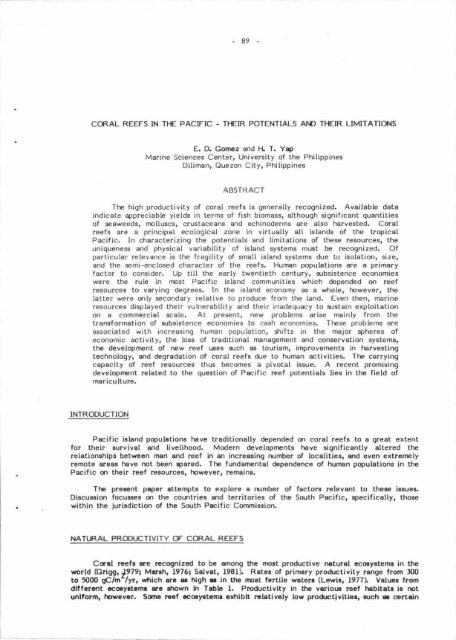Rt€@lll
Rt€@lll
Rt€@lll
You also want an ePaper? Increase the reach of your titles
YUMPU automatically turns print PDFs into web optimized ePapers that Google loves.
-89<br />
CM,AL REEFS IN TI-E PACIFIC - TI-EIR POTENTIALS A}O T}IEIR LIMITATIO{S<br />
E. D. Gomez and l-t T. Yap<br />
Marine Sciences Center, University of the Philippines<br />
Dilimen, Guezon City, Philippines<br />
ABSTRACT<br />
The hiqh productivily of coral reefs is generally recognized. Available data<br />
indicate appreciable yields in terms of fish biomass, although significant quantities<br />
of seaweeds, nnlluscs, crustaceans and echinoderms are also harvested. Coral<br />
reef s are a principal ecological zone in virtually all islands of the tropical<br />
Pacific. In characterizing the potenlials and limitations of lhese resources, the<br />
uniqueness and physical variability of island systems must be recognized. Of<br />
particular relevance is the fragility of small island systems due to isolation, size,<br />
and the semi-enclosed character of the reefs. Human popula[ions are a primary<br />
factor to consider. Up till the early twentieth century, subsistence eeonomies<br />
were the rule in rrpst Pacific island communities which depended on reef<br />
resources to varying degrees. In the island economy as a whole, however, the<br />
latter were mly secondary relative to produce from the land. Even then, rnarine<br />
resources displayed their vulnerability and their inadequacy to eustain exploitaLion<br />
on a commerciel scale. At present, new problems arise mainly from the<br />
transformation of subsislence economies to cash economies. These problems are<br />
associated with increasing human population, strif ts in the major spheres of<br />
economic activity, the loss of traditional management and eonservation systems,<br />
the developrnent of new reef ures s,rch es tourism, improvements in harvesting<br />
teehnology, and degradation of coral reefs d-re to human activities. The carrying<br />
capacity of reef resources thus becomes a pivotal issue. A recent promising<br />
developrnent related to the question of Pacific rcef poLentials lies in the field of<br />
mariculture.<br />
INTRODUCTION<br />
Pacific island populetions have traditionally depended m corel reefs to a great extent<br />
for their survival and livelihood. Modern developncnts have signif icantly altered the<br />
relationahips between man and reef in an increasing rumber of localities, srd even extrerely<br />
remote areas haye not been pared. The fundamental dependence of human populations in the<br />
Pacific m their reef reaources, however, remains.<br />
Tlc prerent paper attenpts to explore a rumber of factorg relevant to these issues.<br />
Discussion focucaes sr the countrieg and territorieg of the South Pacific, specifieally, those<br />
within the jurisdiction of the South Pmific Commiseion.<br />
NATI'RAL PRODUCTIVITY OF CORAL REEFS<br />
Ccal rsefs ere rccognized to be gnong tha moct productive natural cccyrtemr in the<br />
world (Grigg, ]979; Mamh, 1976; Sdvat, l98l). Rater of prirnery prodrctivity range from J00<br />
to 5{100 gClm-lyt, rrhich erc af high l in the rrst fartile watoB (Lewir, 1977\ Valuee from<br />
dlffcrant E6y.tcm! ec drown In Tabb l. Productivity in the vsriou! reaf hebitata is mt<br />
unlform, bwevcr. Sonc rosf ccolytttmr axhiblt ralativaly low productivitiee, qrc*r r csrtain














![R]€@lll](https://img.yumpu.com/7594335/1/175x260/reurlll.jpg?quality=85)
